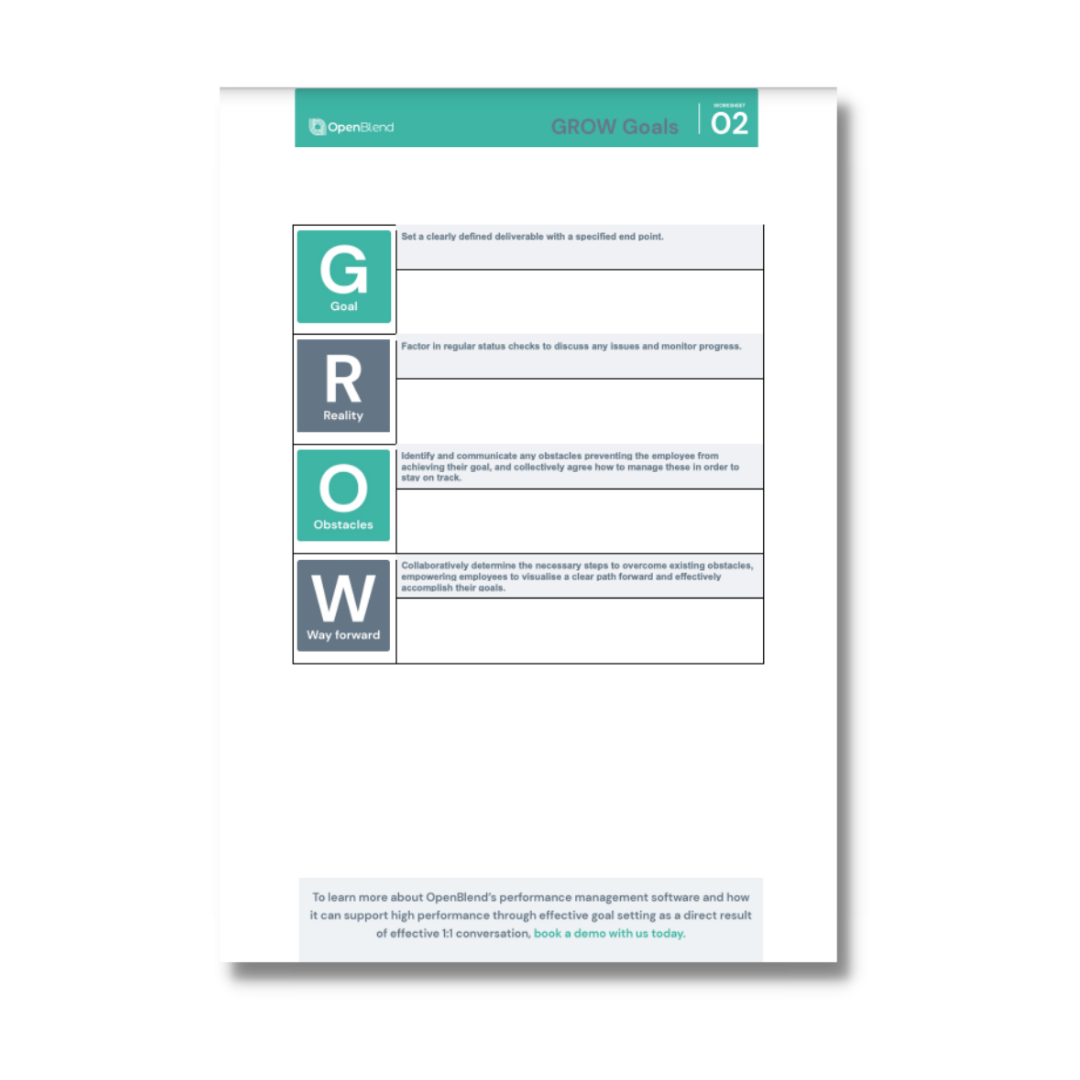OpenBlend Answer:
What are employee performance objectives?

Performance objectives, also widely referred to as employee performance goals, are one of the biggest determining factors for employee performance. Performance objectives are designed to provide employees and teams with a clear and structured understanding of what they need to achieve, whether the goal be performance-based or development-led, and they serve as an essential measure of performance outcomes. Well-designed performance objectives are the key to unlocking employee potential, boosting engagement, and driving business results.
Typically, the goal and objective setting process involves assigning short-term objectives with clearly defined deliverables, and which crucially, must be achieved within a specified time period. Setting performance objectives in this way enables managers - and indeed, employees themselves - to continually track progress against goals and optimise end outcomes.
This guide equips managers with the tools and strategies needed to craft meaningful employee performance objectives. We'll delve into the characteristics of good performance objectives and explore frameworks like SMART to ensure your goals are specific, measurable, achievable, relevant, and time-bound.
Well-designed performance objectives are the cornerstone of a successful performance management process. They move beyond just outlining tasks to create a roadmap for employee growth and achievement. Clear objectives provide a sense of direction and focus for employees, eliminating confusion and allowing them to prioritise effectively. By aligning individual goals with the organisation's bigger picture, employees feel a sense of purpose and understand how their work contributes to overall success. This, in turn, fosters motivation and engagement. Achievable objectives provide a sense of accomplishment, fueling further motivation and ultimately leading to improved performance. With clear benchmarks established, managers can provide targeted feedback and course correction throughout the year, ensuring employees are on track to reach their full potential.
Good performance objectives help employees to focus on achieving their outlined deliverables in a way that supports wider business outcomes. In contrast, bad goals - those that are non-specific and/or poorly understood by the employee - can actually serve to impede performance rather than improve it. Unfortunately, research from Gallup suggests that poor performance goal-setting is a widespread practice, with only half of employees saying they strongly agree when asked whether they know what’s expected of them at work.
The biggest problem associated with obscure goal-setting is reduced productivity. When an employee doesn’t know what’s expected of them, they’re more likely to waste precious time and energy on peripheral tasks that don’t directly support the achievement of their objective. Over time, and at scale, that presents significant losses, both in terms of productivity and profit.
So we’ve established that clarity is key when it comes to employee performance objectives, but what else supports best-practice goal-setting?
Discover a holistic, people-centric approach to performance management.
Tracking and measuring employee performance has long been thought of as the primary purpose of goal-setting. But, while this certainly provides immense value, the benefits don’t stop there. The beauty with performance objectives is that, when done well, they can also act as a driver for engagement and motivation.
An employee who understands the purpose behind what they’re doing will be more able to understand how they’re contributing to the ‘bigger picture’. This context provides a vital connection - and as Dan Pink explains in his three-step motivation model, it’s one that is key to creating intrinsic motivation.
With that in mind, the importance of tying employee goals and performance objectives to organisational goals cannot be overstated.
Learning how to do this is a process in and of itself, but it’s one that can be supported by an effective performance management system. In fact, a study by McKinsey showed that 91% of companies with an effective performance management system are linking employee goals to established business objectives.
Performance goal-setting can support improved engagement and motivation in other ways, too.
At OpenBlend, we advocate for a collaborative approach to goal-setting. One in which the employee or team takes an active role, together with their manager, in helping to define their own objectives. This approach presents a myriad of benefits, but perhaps the greatest win is this: employees who participate in setting their own goals are more likely to take accountability for their performance, and more likely to feel an engagement-building sense of ownership.
Crucially, collaborative goal-setting also promotes increased communication and transparency. It prompts employees and managers to openly discuss potential goals, raise concerns, ask questions, put forward suggestions, and listen to one another before an objective is set. Needless to say, that makes for a much better end result.
There are a number of different methodologies that can be applied to support employee performance goal-setting and the SMART framework & GROW Model are arguably the most well-known and widely used.
The SMART framework ensures objectives are Specific, outlining clear expectations; Measurable, allowing progress tracking through defined metrics; Achievable, setting challenging yet attainable goals; Relevant, aligning with the employee's role and organisational goals; and Time-bound, creating a clear timeframe for completion and fostering focus. By incorporating these elements, you can create a roadmap for employee success and ensure all parties are working towards a shared vision.
First developed in the early 1980s, it cites five key criteria that goals need to adhere to in order to be considered ‘SMART’:
SMART performance objectives provide a clear roadmap for success. For instance, a marketing manager might aim to increase qualified leads from content marketing by 20% in Q3 by publishing two high-quality blog posts monthly. A sales representative could target a quota of $50,000 in new sales by the end of the quarter, focusing on acquiring at least 10 new clients. Finally, a customer service representative might set a goal to reduce customer churn rate by 5% within six months through a new customer satisfaction survey and follow-up program.
✅ An example of a good SMART objective: increase revenue by 5% on Q4 by hosting two prospect events in London
❌ ...and a not-so-SMART objective: increase sales by making more telemarketing calls.
Another objective-setting framework - and one that we live by at OpenBlend, is GROW. Developed around the same time as SMART objectives, the GROW model guides employees and managers along a structured path from goal assignment to goal completion. Here’s how it works:
When applied in the right way, goal-setting frameworks such as these will support the creation of clearly defined and measurable objectives. That’s a big win, but there are some potential drawbacks, too. For example, SMART is sometimes criticised for its lack of flexibility - something that, if not carefully managed, can cause serious detriment to productivity and performance.
Let’s take a deeper dive into this need for agility and flexibility...
Agile performance goals, sometimes referred to as adaptable goals, can be easily adjusted in line with changing micro and macro events. So rather than forging ahead with a goal that has been rendered irrelevant by the shift to remote work, for example, an agile goal can be easily realigned before employee engagement and productivity begin to decline.
In his book, ‘Measure what Matters’, John Doerr introduces Objectives & Key Results (OKRs) - a goal-setting methodology that is especially popular for its amenity to change. OKRs are designed to be regularly revisited and realigned in accordance with evolving employee and organisational needs. For this reason, they’re particularly well suited to high growth companies, as well as organisations that operate in fast-changing industries.
At OpenBlend, we believe goal realignment should be a continual process underpinned by meaningful conversations, ongoing collaboration, and an effective performance management system. We reference the importance of communication and collaboration here because as humans, we are inherently resistant to change. The key to overcoming this lies in facilitating lots of open and honest discussion so that the employee understands why their goal needs to be changed and can become re-invested in achieving their new goal.
Measurable performance objectives are essential for tracking progress and evaluating success. When setting objectives, identify how you'll measure achievement. This could involve using quantitative metrics like sales figures or customer satisfaction ratings, or qualitative measures like the completion of training programs or positive client feedback.
Aligning individual employee performance with the organisation's overall goals is crucial for driving success. Ideally, employee performance objectives should cascade down from the bigger picture. This means clearly communicating the organisation's strategic goals to all employees. Once everyone understands the company's direction, departmental and team goals can be established that contribute to achieving those broader objectives. Finally, with a clear understanding of team goals, managers can develop meaningful performance objectives for each individual. These individual objectives should "ladder up" to team and departmental goals, ensuring everyone's efforts are working in concert towards the collective success of the organisation. By following this approach, you create strong employee performance objectives and a performance management process where individual goals contribute directly to achieving the company's strategic vision.
Of course, in the new world of remote work where goals are now largely discussed and agreed with the help of virtual communication platforms and performance management software, there’s an even greater need for meaningful performance conversations and clear goal-setting. As part of this, employees should have 24/7 access to a record of their goals, as well as visibility of company objectives so that they can see the company’s vision, and understand how their work is contributing to achieving that.
With the right combination of methodology and technology, good performance goal-setting can - and will - support business growth. To learn more about the OpenBlend performance management tool and how it can support performance management in your organisation, book a demo with us today. Or, for more information, you can contact us on 01628 613040 or email hello@openblend.com. We’d love to hear from you.
Download OpenBlend's performance objectives worksheet today and start crafting your own performance goals using the GROW framework.

OpenBlend needs the contact information you provide to us to contact you about our products and services. You may unsubscribe from these communications at anytime. For information on how to unsubscribe, as well as our privacy practices and commitment to protecting your privacy, check out our Privacy Policy.